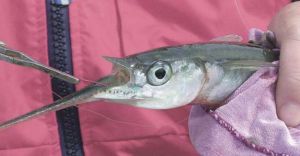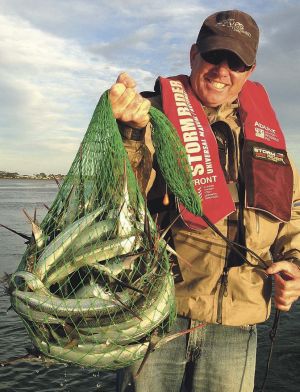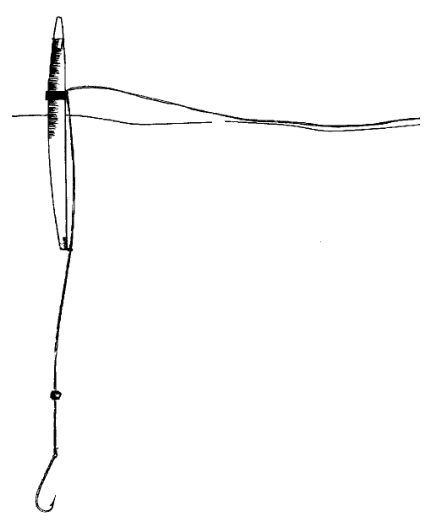 Presented from Issue 110, June 2014
Presented from Issue 110, June 2014
I think ‘Gars on George’ would be a terrific name for a restaurant. In fact, I think that Georges Bay on Tasmania’s lovely east coast is one of the best seafood restaurants I have ever been to. All the great fish are in the bay and they are ever so fresh if you are good enough to catch them. calamari, salmon, mullet, trevally, flathead, leather jackets, bream and whiting are more or less in abundance.
What more could you want? garfish - I say ! I just love them. Both the catching and the eating of them.
Gars have a delicate sweet flesh that eats superbly with a light salad a few lemon wedges and a bottle of Pinot Gris. Could a feed of fish get any better than that?
 I guess my past dictates that I am predominately a fly fishing trout fisherman and this makes me an automatic sucker for garfishing. Firstly, catching gars is best done in Georges Bay in winter when the trout season is closed. Secondly, with good polaroids and a sunny day the fish are obvious and with good berleying techniques and a little luck they are both prolific and visual.
I guess my past dictates that I am predominately a fly fishing trout fisherman and this makes me an automatic sucker for garfishing. Firstly, catching gars is best done in Georges Bay in winter when the trout season is closed. Secondly, with good polaroids and a sunny day the fish are obvious and with good berleying techniques and a little luck they are both prolific and visual.
Furthermore, whilst catching a few for a feed is more or less easy enough for anyone to do - there is certainly a knack to catching sheds full of them anytime you want. A real life example of this happened to me recently when I fished with two keen, and competent, trout fishing mates.
The day started well when we arrived mid morning to find a sunny day with light winds. The clear water of the bay sparkled as we drove along the foreshore scanning for birds working schools of baitfish pushed upwards by schooling salmon.
We hit the water and searched for half an hour. Eyes scanning for nought, not even good binoculars could help us find birds, or fish. We searched a rocky outcrop here and a channel there with soft plastics to no avail. It was time to change the plan.
I was so keen to target the gars. There were already several boats anchored up on the edge of the channel markers. The berley slicks were obvious as we anchored a respectable distance above them. A few fish were being caught - but not many. Maybe one every five minutes would come aboard one boat or another.
This was not record setting by any means but they were sweet gars none the less. It all looked good to go. IMHO* (there’s a modern complication for my spell check) the 6’6” spin sticks matched with Shimano reels and the very best gel spun lines whilst being great for many of the other species were far from ideal tackle for the Gars.
I rigged one rod up with a small float, a 60 cm dropper and a long shanked # 8 hook that was held low in the water by a split shot. I tested the rig overboard and found that the float needed a further split shot to ballast the rig deeper.
The lower float offers less resistance is to the feeding gars when they take the bait and attempt to swim off with it – I am sure they hold the bait longer and are more likely to swallow it deeper with the decreased resistance.
Mike tethered a berley bucket over the transom and as soon as it hit the water he asked us to remind him to pull it inboard before we motored off. Memories flooded back of me making this exact same mistake once and I wondered how many berley buckets have been munched up by outboard motors in Georges Bay.
Within minutes we had schools of beautiful long, slender fish darting through the trail and I had an ear-to-ear grin.
 |
| Prime Winter garfish from St Helens |
The only bait we had was a loaf of bread and I soon had a piece wadded up and pressured onto the hook of the bend. The first four drops (it is best to drop the float overboard rather than cast it) resulted in stolen baits. The fifth attempt resulted in the first fish on board. It went straight into the fish bin, wiggling like mad. A cloth on the side of the bin is used to get them in a squirrel grip so you can remove the hook. The ice slurry in the insulated bin slows them down quickly; more bait and into it again.
The stolen bread issue really hampered the catch rate but I am guessing I caught one every fifth run which was substantially more than the frequency at which the other boats scored. Mike tried a strip of gar on the hook and caught enough to be happy but deep down he knew he too was behind the eight ball with his catch rate given the number of fish now swimming behind our boat.
Mike switched to a little white jig fly and I moved onto a piece of white tee shirt cotton material rubbed in fish slime. Whilst the fish could not get my bait off the hook at all, the takes were less frequent, half hearted tugs resulting in poor hook up rates. It was back to the bread for me.
Whilst Mike and I were catching plenty of fish our mate failed to master the situation and caught perhaps 1/10 the number of our fish. It was clear to us that whilst the fish were there in numbers they were not suckers and you needed to have a degree of finesse about how you went about catching them. The other boats certainly didn’t seem to have perfected a decent gar-catching technique either.
To start with I think the fish wanted the bait more or less at their depth. They also wanted it completely free drifting. If there was an ounce of unnatural drag they would simply let it pass them by. Put simply, a static rod with a float cast back behind the boat and a closed bail resulted in a static bait swinging tethered in the current. This situation was lucky to yield just one bite every 10 minutes.
By simply floating the bait from beside the boat with an open bail it made the world of difference – the bait often being solidly scruffed within the first 20 feet of drift. On the odd occasion that you did not get a take if you then raised the rod – thereby drawing the float and bait toward you five metres then lowering the rod to allow slack and a free floating bit, you would be odds on to get lucky. Mike and I managed a bite a minute, or better, in this manner.
Even with the tee shirt bait. In an hour or so of terrific fun my like minded mates and I shared stories about all aspects of life. The fishing was visual and it required certain skill and concentration. We messed with different methods all the time trying to refine the catch rate. Learning something about this humble little fish that was so good on the table (plate?) and that punched way above his weight with head shaking and aerial acrobatic fighting qualities. Learning how to really catch out any fish species always teaches you something about how to catch other species too.
What a great day we had. Get out and have a crack yourself this winter.
The secret
You want to know the secret , the real secret to successful Garfishing here? Listen up.
 |
| This is a pretty typical garfish float setup. However adjust or change it to suit yourself. |
The next time I go to St Helens garfishing I will have the ideal rig with me. I learnt long ago that a 9’ or preferably 10’ fly rod is best. Use a light one to increase the fun. Couple this with a floating line and a short leader of 5 feet of 4 pound mono. Use a long shank #10 hook for best results and bait it with a strip of chicken skin. Yep, that’s right, chicken skin. I buy a wing from the IGA and it will cost you 41 cents. There is no need to be embarrassed when you buy just one wing as I think the staff there are used to us nutters.
A 1 cm long and ½ cm wide strip of skin (no flesh) will last you all day and the fish simply cannot get it off the hook. Additionally, the fish like chicken skin more than I like Turkish Delight and that is saying something.
Make a roll cast beside the boat and mend line into the cast such that it all floats down current completely drag free. Run it back perhaps 30 feet as a maximum before repeating the process. All the while watch the flyline and as soon as a fish ‘draws it’ away you should SMOOTHLY draw back to set the hook. It is really important not to strike aggressively and I always wonder how a small circle hook would go for this situation. I bet that it would be better.
Cleaning and preparing Garfish
I’ve heard all sorts of stories about the best way to prepare gars and I have tried most of them. I will stick to my method.
Behead and gut the gars as you go if you can.
Otherwise sitting down to do a trailer-load of them is a laborious job.
Use a scaling bag that you can buy affordably from Jamie Henderson at St Helens Bait and Tackle. You simply toss the fish in this bag and tow them around for a few minutes shaking them occasionally to reset the bag and allow the loose scales to wash away.
Then have a look at the guy filleting them on Youtube. Go to the link https://www.youtube.com/watch?v=ZQAny0kXwsk
He uses a sharpened bone handled table knife to butterfly the fillets (this gives one fillet off two sides rather than 2 separate fillets. I go a step further and slice out the pin bones too. You now have a beautifully prepared Garfish. No bones and no scales. Flour them lightly and do in a hot buttered pan.
Peter Hayes
